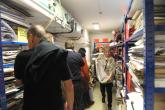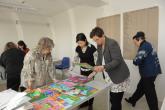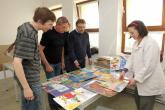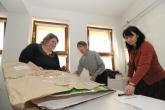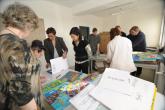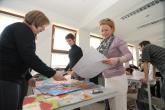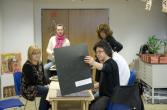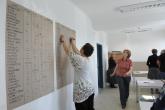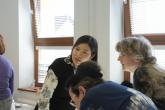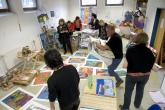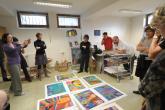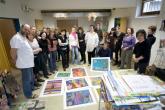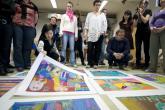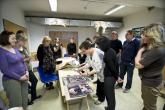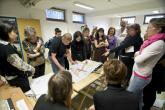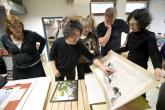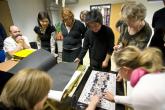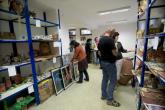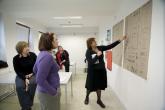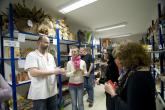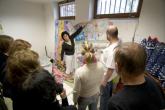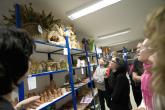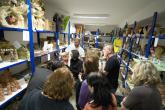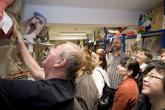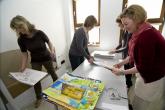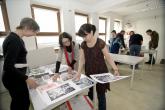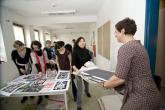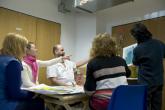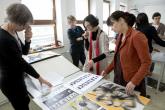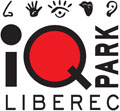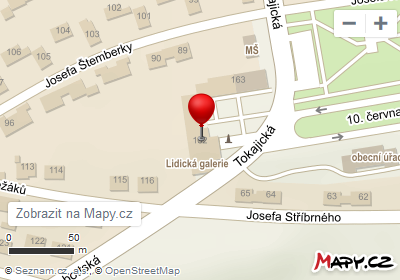Homepage » Archived editions » 39th edition » Panel of judges
Panel of judges
The expert panel of judges is made up of teachers of visual art branches at primary art schools and primary schools and of professional visual artists. The number of judges is not fixed, however, the panel has usually 15 - 23 judges. Many of them have engaged in the work with children for many years and also are judges in other art competitions which enhances their knowledge about the quality of art education of children in the schools in our country and abroad.
Report of the Session of the Expert Panel of Judges Held on 7 – 8 April 2011 to Evaluate the 39th ICEFA Lidice 2011
Members of panel of judges 40. ICEFA Lidice 2011
Chairman of the panel:
Zedník Josef - an artist, Olešná
Members from Czech Republic
Homola Martin – a photographer, Buštěhrad
Chmelařová Monika – a teacher at the Primary Art School Mšeno
Junková Ivana – the headmaster of the Primary Art School Řevnice, a teacher at VSUP Prague, sculptor
Jurková Hana – the headmaster of Private Art School Jeseník
Krupková Křesadlová Lada – a photographer and teacher at the Primary Art School Biskupská, Prague 1
Moupic Zdeněk – a teacher at the Primary Art School Olomouc
Němcová Kateřina – a teacher at the House of Children and Youth Ulita, Prague 3
Rajdl Pavel – a teacher at the Primary Art School Kolín
Sobková Milada – a methodologist at the House of Children and Youth Šumperk Spěváčková Jaroslava – a teacher in the visual art department of the Primary Art School Plzeň
Schwarzová Ivana – a teacher in the visual art department of the Primary Art School Strakonice
Stará Lada – a teacher in the visual art department of the Primary Art School Nové Strašecí
Synecká Zdena – a methodologist at ARTAMA Praha
Vlčková Zuzana – a teacher at Gymnázium Kladno
Members from abroad
Kiška Igor - a teacher at the Primary Art School Skalica, Slovak Republic
Kišková Mária – a teacher at the High School Skalica, Slovak Republic
Sherring Amanda – a teacher at the Thettford Grammar School, Great Britain
De Graeve Emi – an artist, Meerbeke, Belgium
Lau Henry a Iris – teachers at Simply Art, Hong Kong, China
The theme of this year’s international fine arts competition “THAT IS WHERE I LIVE, THAT IS ME” (and the sub-themes: my country and its natural, architectural and historical attractions and particularities, my country’s monuments listed by UNESCO, town, village where I live, where I like to be, my home – the place where my family lives, my room – my kingdom) attracted children and teachers to such an extent that they contributed to the record number of the this year’s entries. In total, the panel assessed 25,450 areal and spatial entries from 66 countries. There were a lot of architecture among the entries, many houses, cottages and gardens, little rooms, dolls and toys; the panel could see a wide range of cities, towns, villages and historic monuments, enjoyed many self-portraits, portraits of family members, eaters, sleepers and friends. Large spatial entries of ceramics, wirework and paperwork caught the eye of the panel immediately. The first overall impression was very optimistic and bright and the work of the panel of judges was not easy.
Members of the international panel of judges appreciated and commended those schools, over a half of their total number, that had sent in thoughtfully created collections based on the knowledge of the means of expression in fine arts, refined collections containing sensitively and discriminatingly selected entries. These schools are to be thanked for their responsible approach and motivated to continue their work. It is obvious that high-quality education in art and the professional approach of individual teachers are the prerequisites of good results.
However, compared with the theme of the previous year, biodiversity, and in spite of all pluses mentioned above, this year’s theme proved to be unexhausted. Many entries limited themselves to what is obvious at the first sight, not going more deeply into the matter. Though there were more entries this year than in the previous one, the quality was not much improved ant the theme did not get what it deserved. Let us consider probable causes: It is possible that the theme did not suit well to some of the schools and teachers; the other, more disturbing cause may be a certain perfunctoriness, superficiality and maybe even unwillingness to concentrate and think over what the given theme might offer. Though the number of the entries is growing, there are still many of those that speak of inconsistency, lacking a conceptual approach. These entries are dull and of poor quality, indicating that the children had not been taught about the materials and their potentials in visual arts. These entries show a lack of interest of the teachers, their superficial, perhaps a rather perfunctory approach. It must be said that such an approach misses the target. It may be true that many teachers do not have the right education in art; we infer that from the entries that show no signs of artistic thinking, no awareness of the potential of the creative means of expression and of art techniques. A certain decline in the artistic quality can be seen also in spatial entries; a number of them demonstrate a lack of the teacher’s knowledge of materials (e.g. ceramic clay, glazes, engobes, processing technologies) and to some extent, artistic insensitivity, which may be due to the lack of education. A ceramic kiln is virtually in every school nowadays; it does not mean, however, that the children get the best information about the technology and the creative possibilities. The schools concerned have a way out of this situation – further education and training of art teachers. The schools and teachers could benefit from viewing the exhibition if the distance allows it.
ASSESSMENT OF FOREIGN ENTRIES
This year we received entries from 66 countries, many of which participated in the exhibition for the first time (Algeria, Belgium, Brunei, Djibouti, Kyrgyzstan, Panama and Turkmenistan). Some countries had more schools participating, which was due to excellent co-operation of the Czech diplomatic missions (e.g. Azerbaijan, Armenia, Latvia, Lithuania, Uzbekistan) or due to personal engagement of individuals who have personal ties or historical links to Lidice (Mr. and Mrs. Gerrard from Stoke-on-Trent in the UK, the town of Lidice in Panama). However, the numbers of entries from individual countries widely varied; besides big collections from Belarus, Bulgaria, Latvia, Russia, Turkey, Ukraine and newly also from Hong Kong, there were also countries represented by only several entries, often from a single school (Bangladesh, France, Italy, Cape Verde Islands, Hungary), so that it was impossible for the panel to assess the artistic standard of the country and to select the very best of it.
Seeing the entries, the panel appreciated national traditions and features of the respective countries as well as the opportunity to look into the privacy of the children – everybody was keen to see the monuments as well as the towns, houses and rooms of the young artists. As has become a tradition, among the well-received entries were those by children from Bulgaria, India, Latvia (with Latvia sending the best entries from the “preliminary exhibition” held by the Czech embassy in Riga), Malaysia, Russia and Turkey, which had a very rich and high-quality collection. In the field of photography, the expert panel of judges appreciated outstanding collections by children from Croatia, Russia and Ukraine. Standing out among spatial foreign entries, the collection of glass items and stained-glass panes from Latvia was a great success as every year. However, the quality of some spatial entries from abroad remains doubtful; it is typical namely for Asia that the entries demonstrate the wish to please, pandering to popular taste, as well as a certain insensitivity to materials demonstrated in unsuitable choices. A lingering problem is a large extent of entries damaged in delivery by post.
As every year, we again encountered the problem of poor identification, especially in some foreign entries (Azerbaijan, Egypt, Tunisia, Mongolia and Uzbekistan). It cannot be over-stressed that a carefully made description in capitals, in Roman alphabet, is a prerequisite of the acceptance of the entry into the exhibition.
ASSESSMENT OF CZECH AND SLOVAK ENTRIES
Also Czech and Slovak entries displayed enjoyment of their creators in depicting everything that surrounds them at their place. The themes that occurred frequently were hometowns with their monuments as well as landmarks of the Czech Republic, houses, nooks and little rooms, family and relatives. The areal entries comprised mainly colour drawings and paintings, prints and drypoint engravings. Compared with the foreign entries, there were few pencil drawings, collages and entries made with pasting techniques. As against children from abroad, Czech schools were in a better position to send in 3D entries, including breakable entries of ceramics. This year, they sent in sculpted plazas, streets, riverbanks as well as individual landmarks; churches, castles, chateaux and child’s rooms were made from a variety of materials with wide-ranging techniques.
The organizers and the panel of judges were pleased by the fact that much more schools from the Czech Republic and from the Slovak Republic took part in the exhibition this year. As in the previous year, entries by children from primary art schools gained greater success (Blatná, Čelákovice, Háj ve Slezsku, Holešov, Jeseník, Kolín, Krnov, Mladá Boleslav, Most, Olomouc, Pečky, Pelhřimov, Písek, Plzeň, Prostějov, Strakonice, Šternberk and Zlín Malenovice) due to the systematic and professional work of the teachers. However, all the more the panel of judges values the quality work of teachers at nurseries, (Dolní Cerekev and Lišov) primary (Bělčice, Buštěhrad, Dvůr Králové nad Labem, Hořovice, 15. ZŠ Plzeň, Sedmikráska Rožnov pod Radhoštěm and Studená), special (Arpida České Budějovice, Duha Písek, Special Nursery School and Centre Jihlava, Special Nursery School Kladno, Domov Raspenava) or secondary schools as well as at houses of children and youth (Bájo Česká Skalice, Paletka Plzeň, House of Children and Youth Prague 2 – Art Studio Vinohrady, Prague 9, Měšická). The photo collections are being more and more plentiful; an outstanding collection was sent in again by the Primary Art School Nymburk this year. As to the spatial entries, the panel of judges enjoyed the ceramics from the Primary Art School Kolín and Český Krumlov, 3D entries from the House of Children and Youth Ulita, wirework from the Primary Art School Strakonice and objects from the Primary art School Mšeno.
There were also more Slovak schools participating in this edition than in the previous one, namely in the category of special schools. Great success goes to the Nursery School Stella in Poprad and the Nursery School Skalica, the Primary School Rajec and the Primary School Hliny Žilina, the Primary Art Schools Banská Bystrica, Bojnice, Holíč, Kežmarok, Michalovce, Prešov, Skalica, Spišská Belá and Gaštanová Žilina.
Prizes
Out of the total 25,450 entries from 66 countries 1,471 were selected by the panel of judges to win prizes including 212 medals. Out of 15,983 foreign entries 622 won prizes, among them 92 medals (67 individual medals and 25 medals to schools for their collections). The most medals were given to children from Bulgaria, Latvia, Russia, Turkey and Ukraine.
Czech children sent in 6,765 entries this year and received 606 prizes including 88 medals (49 individual medals and 39 medals to schools for collections). The most successful were children from Primary Art School Kolín, Primary Art School Most, Primary Art School Plzen and Primary Art School Strakonice. Having sent in 2,702 entries this year, Slovak schools received 243 prizes including 32 medals (19 individual ones and 13 medals to schools). The most successful participants were children from Primary Art School Banská Bystrica, Primary Art School Holíč, Primary Art School Michalovce, Primary Art School Prešov and Primary Art School Spišská Belá. The international panel of judges awarded the Prize of the Panel of Judges to the school Simply Art from Hong Kong. Besides achieving outstanding results in the exhibition every year, this school sent in a balanced and unique collection of areal entries this year.
Conclusion
Our thanks go to all who took part in the competition, to all who drew, painted or modelled their vision of the given theme and sent their creations to the competition, regardless of whether they won a prize or not. Thanks to those contributions, this year’s exhibition is again a unique one! We thank also to all teachers because it is the character of the teacher, his skill, knowledge, zeal and responsibility what plays a vital role in good results of children’s art work.
Josef Zedník
Chairman of the panel of judges of the 39th ICEFA Lidice
Ivona Kasalická
Head of the Lidice Gallery and Curator of ICEFA Lidice


